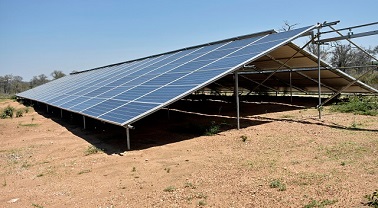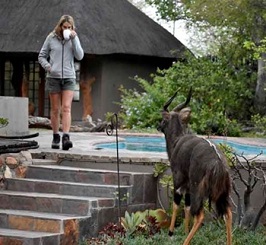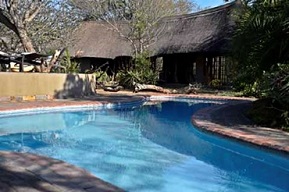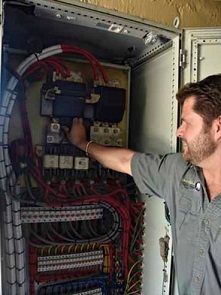
KRUGER NATIONAL PARK, SOUTH AFRICA—In nature, nothing goes to waste, and nothing is left over in the ecosystem of South Africa’s bush country, which is home to Kruger National Park and numerous game reserves.
Thousands of visitors flock there every year to see animals in as-close-as-you-can-get to their natural environment, where even animal bones provide food for some animals and help others keep their teeth healthy.
That ecosystem is the inspiration for Bryce Landsman, the owner of the Kambaku Safari Lodge and Kambaku River Sands in the Timbavati Game Reserve, located on the western border of Kruger. His lodges went totally solar-powered this past autumn (March through June in South Africa), and his goal is to make them entirely sustainable in the next year with no traces of human life—including trash—left over.
The older Kambaku Safari Lodge consists of eight huts, each self-contained with private baths and showers. They normally house 16 guests, but some of the huts can accommodate families. The lodge also has a pavilion with a gift shop and office area, where the Wi-Fi signal is strongest, as well as a swimming pool and guest pavilion with a bar and seating area that adjoins the kitchen. Kambaku River Sands accommodates 20 guests, and its huts have air-conditioning and dust-control systems. River Sands also houses a climate-controlled wine cellar, larger gathering facilities, and a spa with a massage facility for guests of both lodges.
“Nothing is forfeited in terms of guest comforts,” Landsman said. “We’ve started to push our green message, and people have been pleased and impressed. But our guests still want their creature comforts, such as hot water; lighting in their huts (all LED); the power to recharge batteries for computers, cameras and devices; and internet connections. We’re able to provide for all their needs, and we’re improving our hot-water supply with a gas system that turns on and off electronically. We have no pilot lights.”
Gas is also used for all cooking at both lodges, and solar-generated power keeps the gas systems running for freezers and refrigerators. Solar power is at the heart of the operation and the ambiance.
Right Direction

The five-year-old solar system at Safari Lodge has 100 north-facing panels, while the newer River Sands system has a total of 400 panels. Two hundred of the panels face north, while 100-panel arrays face east and west, respectively. For River Sands, Landsman decided to go with the multiple stationary arrays instead of a system of movable arrays to save space and provide more power for the battery systems that store the energy. The panels get weekly washings, and Safari Lodge just experienced its first cracked panel. Because that particular panel is no longer available, Landsman installed a new four-panel section and put the three remaining panels in inventory for spare parts. It was the first replacement needed since the system’s installation.
River Sands incorporates newer, more efficient solar panels as well as a newer, more efficient system of storage batteries, inverters and monitoring and communications technology. The systems power all the pumps for the water systems and pools, and those pumps are specially designed to run on solar power. Landsman says he has an investment of ZAR 2 million ($142,000) and is five years into an estimated eight-year ROI. The River Sands investment is ZAR 8 million ($567,000), and his ROI, currently estimated at 12 years, will depend in large part on how quickly the rates rise from Eskom, South Africa’s electric utility.
“We’ve had annual increases in the cost of our government-supplied power, and it’s been irregular,” Landsman noted. “Power accounts for 20 percent of our operating costs.”
Once you get off the paved road that serves the Timbavati reserve, there’s something about seeing utility poles and lines that detracts from the experience of seeing animals, plants, and the landscape in an environment that’s as close to pristine as possible.
Meeting New Guest Needs

It’s not Landsman’s first time off the power grid. He was at a game reserve in Botswana nearly 20 years ago that installed generators to feed power to banks of storage batteries. In turning to solar this time, he opted for a sustainable solution that could meet the increased power needs and comfort requirements of today’s tourism market with the lowest impact on the environment.
Virtually all guests insist on being able to recharge batteries for cameras and devices—sometimes computers, too—so they can take pictures and videos of their lifetime vacation and share them on social media. Many use the internet, too, to stay in touch with others or to monitor business. Wi-Fi is crucial because cellular service is not readily available.
Landsman is always mindful that his guests pay a lot of money for a once-in-a-lifetime experience, and the ambience at both lodges must enhance it. The solar installations have turned him into a self-described city manager. In addition to the lodges, the power system serves staff residence facilities and Landsman’s family home on the property.
Without getting into a detailed explanation, the solar energy at each location is run through a system of inverters that convert the power for storage in banks of lead acid batteries. Landsman finds the battery system to be reliable, even though it’s a mature technology. The batteries can handle the heat of the bush country, which can reach 1000F, and they enable the systems to reboot quickly after severe thunderstorms. Both power-generation systems have automated controls that send excess power from one lodge to the other if needed, and they keep a 180-day operating history.
Landsman is planning on his original system at Safari Lodge lasting 12 years, and he figures he can always change out the technology if something better is available. He grounds his optimism on the fact that he has a totally different, more efficient system at River Sands. The older system is from a U.S. supplier, and the newer system is a Bulgarian product that was developed for military use.
About the only equipment at the lodges that won’t go green are the open Land Rovers with stadium seating that are used to take guests on two daily game rides. Landsman looked at EVs, but they’re not practical for a number of reasons. The key drawbacks are that the vehicles can cover a lot of territory over extremely rough terrain during a four-hour ride, and getting stranded 10KM or more from a lodge would be disastrous. In addition, a vehicle-charging system would require a large investment, and Landsman believes his solar investment could be better used for the lodges or residential facilities.
Bush Country Quirks

Landsman notes that going green in the bush country has its own particular quirks, such as protecting all equipment from animals as large as elephants to as small as geckoes and termites. Baboons can be destructive, too. Solar arrays are fenced, while the buildings that house power inverters, storage batteries, and communications systems all need to be sealed on the outside and inside.
“We’re the first lodges in Timbavati to go entirely solar, and River Sands is the largest solar-powered lodge,” he said. “We’re custodians of this place, and the lodge does have an impact, but our goal is to preserve the environment. We are moving toward no waste. Every product we use or will use is biodegradable, recyclable or reusable. We’re going to get rid of plastic water bottles by having filtered water available throughout our lodges and giving everyone aluminum bottles that they can refill and then take as a souvenir.”
Landsman hopes that fellow lodge owners and private home owners in Timbavati follow his lead. Some have smaller solar systems, and he gets a lot of visitors who want to learn more about his system and experience.
“We want to do more for the game, because that’s what people come to Western Kruger to see,” he said.







Great to hear this fantastic camp is going green we loved our 2 visits to the camp.love the idea of refillable water bottles.keeping up the quality of this place without the impact on the environment will be a challenge .good luck and best wishes to the family and David and his team if he’s still manager .